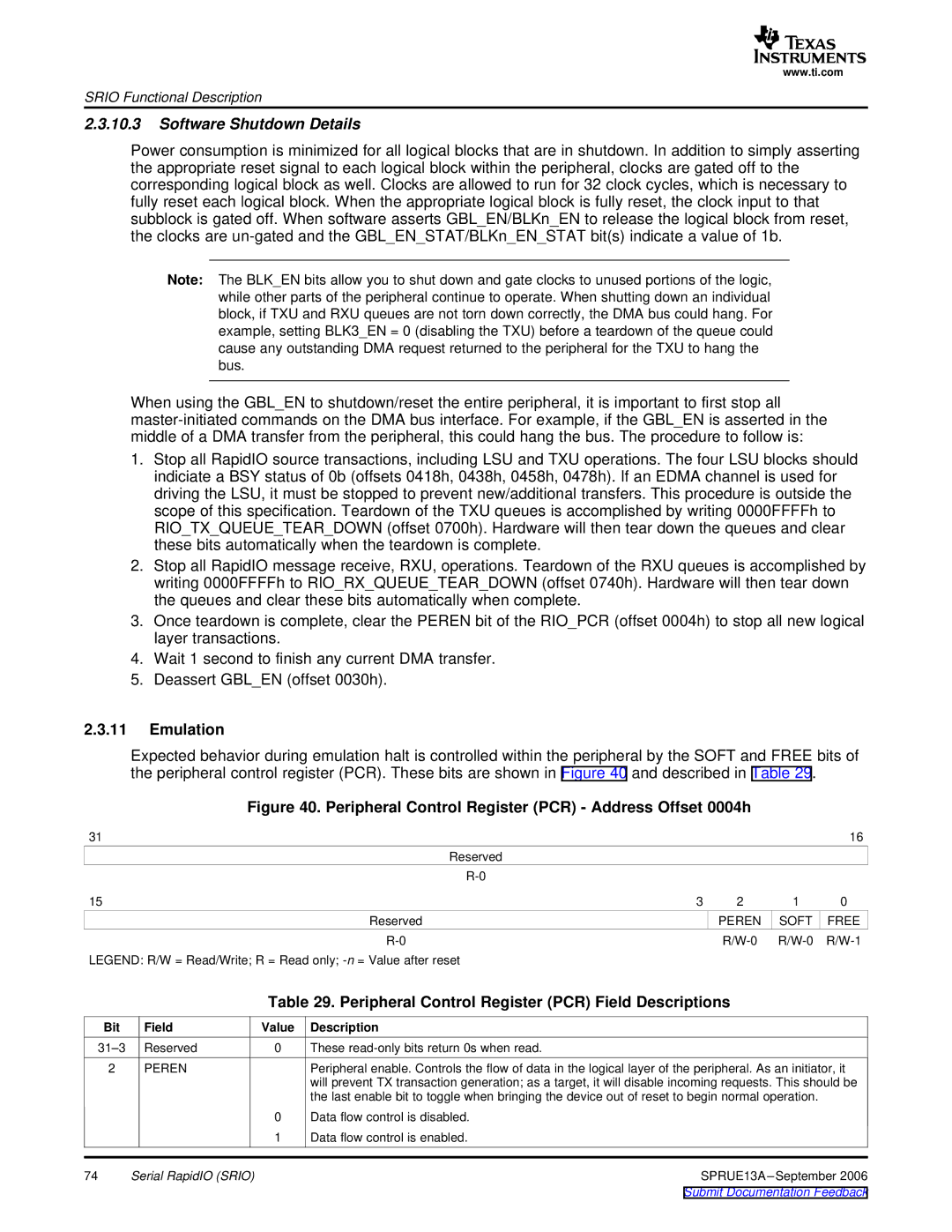
www.ti.com
SRIO Functional Description
2.3.10.3Software Shutdown Details
Power consumption is minimized for all logical blocks that are in shutdown. In addition to simply asserting the appropriate reset signal to each logical block within the peripheral, clocks are gated off to the corresponding logical block as well. Clocks are allowed to run for 32 clock cycles, which is necessary to fully reset each logical block. When the appropriate logical block is fully reset, the clock input to that subblock is gated off. When software asserts GBL_EN/BLKn_EN to release the logical block from reset, the clocks are
Note: The BLK_EN bits allow you to shut down and gate clocks to unused portions of the logic, while other parts of the peripheral continue to operate. When shutting down an individual block, if TXU and RXU queues are not torn down correctly, the DMA bus could hang. For example, setting BLK3_EN = 0 (disabling the TXU) before a teardown of the queue could cause any outstanding DMA request returned to the peripheral for the TXU to hang the bus.
When using the GBL_EN to shutdown/reset the entire peripheral, it is important to first stop all
1.Stop all RapidIO source transactions, including LSU and TXU operations. The four LSU blocks should indiciate a BSY status of 0b (offsets 0418h, 0438h, 0458h, 0478h). If an EDMA channel is used for driving the LSU, it must be stopped to prevent new/additional transfers. This procedure is outside the scope of this specification. Teardown of the TXU queues is accomplished by writing 0000FFFFh to RIO_TX_QUEUE_TEAR_DOWN (offset 0700h). Hardware will then tear down the queues and clear these bits automatically when the teardown is complete.
2.Stop all RapidIO message receive, RXU, operations. Teardown of the RXU queues is accomplished by writing 0000FFFFh to RIO_RX_QUEUE_TEAR_DOWN (offset 0740h). Hardware will then tear down the queues and clear these bits automatically when complete.
3.Once teardown is complete, clear the PEREN bit of the RIO_PCR (offset 0004h) to stop all new logical layer transactions.
4.Wait 1 second to finish any current DMA transfer.
5.Deassert GBL_EN (offset 0030h).
2.3.11Emulation
Expected behavior during emulation halt is controlled within the peripheral by the SOFT and FREE bits of the peripheral control register (PCR). These bits are shown in Figure 40 and described in Table 29.
Figure 40. Peripheral Control Register (PCR) - Address Offset 0004h
31 |
|
|
| 16 |
Reserved |
|
|
|
|
|
|
|
| |
15 | 3 | 2 | 1 | 0 |
Reserved |
| PEREN | SOFT | FREE |
| ||||
LEGEND: R/W = Read/Write; R = Read only; |
|
|
|
|
Table 29. Peripheral Control Register (PCR) Field Descriptions
Bit | Field | Value | Description |
Reserved | 0 | These | |
2 | PEREN |
| Peripheral enable. Controls the flow of data in the logical layer of the peripheral. As an initiator, it |
|
|
| will prevent TX transaction generation; as a target, it will disable incoming requests. This should be |
|
|
| the last enable bit to toggle when bringing the device out of reset to begin normal operation. |
|
| 0 | Data flow control is disabled. |
|
| 1 | Data flow control is enabled. |
74 | Serial RapidIO (SRIO) |
| SPRUE13A |
